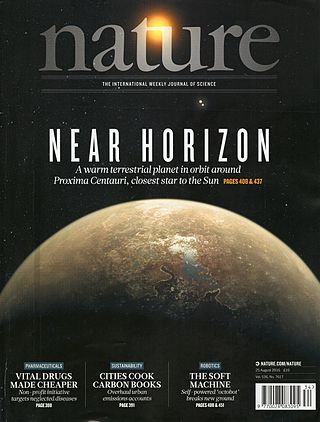
In academic publishing, a scientific journal is a periodical publication intended to further the progress of science, usually by reporting new research.

Nature is a British weekly scientific journal founded and based in London, England. As a multidisciplinary publication, Nature features peer-reviewed research from a variety of academic disciplines, mainly in science and technology. It has core editorial offices across the United States, continental Europe, and Asia under the international scientific publishing company Springer Nature. Nature was one of the world's most cited scientific journals by the Science Edition of the 2019 Journal Citation Reports, making it one of the world's most-read and most prestigious academic journals. As of 2012, it claimed an online readership of about three million unique readers per month.

In journalism and mass media, sensationalism is a type of editorial tactic. Events and topics in news stories are selected and worded to excite the greatest number of readers and viewers. This style of news reporting encourages biased or emotionally loaded impressions of events rather than neutrality, and may cause a manipulation to the truth of a story. Sensationalism may rely on reports about generally insignificant matters and portray them as a major influence on society, or biased presentations of newsworthy topics, in a trivial, or tabloid manner, contrary to general assumptions of professional journalistic standards.

Academic publishing is the subfield of publishing which distributes academic research and scholarship. Most academic work is published in academic journal articles, books or theses. The part of academic written output that is not formally published but merely printed up or posted on the Internet is often called "grey literature". Most scientific and scholarly journals, and many academic and scholarly books, though not all, are based on some form of peer review or editorial refereeing to qualify texts for publication. Peer review quality and selectivity standards vary greatly from journal to journal, publisher to publisher, and field to field.

Scientific literature comprises scholarly publications that report original empirical and theoretical work in the natural and social sciences. Within an academic field, scientific literature is often referred to as the literature. Academic publishing is the process of contributing the results of one's research into the literature, which often requires a peer-review process.
Scientific consensus is the generally held judgment, position, and opinion of the majority or the supermajority of scientists in a particular field of study at any particular time.

Credibility comprises the objective and subjective components of the believability of a source or message. Credibility dates back to Aristotle theory of Rhetoric. Aristotle defines rhetoric as the ability to see what is possibly persuasive in every situation. He divided the means of persuasion into three categories, namely Ethos, Pathos, and Logos, which he believed have the capacity to influence the receiver of a message. According to Aristotle, the term "Ethos" deals with the character of the speaker. The intent of the speaker is to appear credible. In fact, the speaker's ethos is a rhetorical strategy employed by an orator whose purpose is to "inspire trust in his audience." Credibility has two key components: trustworthiness and expertise, which both have objective and subjective components. Trustworthiness is based more on subjective factors, but can include objective measurements such as established reliability. Expertise can be similarly subjectively perceived, but also includes relatively objective characteristics of the source or message. Secondary components of credibility include source dynamism (charisma) and physical attractiveness.
The science wars were a series of scholarly and public discussions in the 1990s over the social place of science in making authoritative claims about the world. HighBeam Encyclopedia, citing the Encyclopedia of Science and Religion, defines the science wars as the discussions about the "way the sciences are related to or incarnated in culture, history, and practice. These discussions came to be called a "war" in the mid 1990s because of a strong polarization over questions of legitimacy and authority. One side of the controversies is concerned with defending the authority of science as rooted in objective evidence and rational procedures. The other side argues that it is legitimate and fruitful to study the sciences as institutions and social-technical networks whose development is influenced by linguistics, economics, politics, and other factors surrounding formally rational procedures and isolated established facts."
Science by press conference or science by press release is the practice by which scientists put an unusual focus on publicizing results of research in the media, in the form of press conference events or press release statements. The term is usually used disparagingly. It is intended to associate the target with people promoting scientific "findings" of questionable scientific merit who turn to the media for attention when they are unlikely to win the approval of the professional scientific community.
Self-censorship is the act of censoring or classifying one's own discourse. This is done out of fear of, or deference to, the sensibilities or preferences of others and without overt pressure from any specific party or institution of authority. Self-censorship is often practiced by film producers, film directors, publishers, news anchors, journalists, musicians, and other kinds of authors including individuals who use social media.
A scientific celebrity or celebrity scientist is a scientist who has gained significant public attention, usually through the media. For the general public, scientific celebrities serve to represent science or a field of science, usually in an unofficial capacity. In some instances, such promotion can be self-serving in nature, can be at the behest of governmental or corporate interests or to promote the science involved.

Science journalism conveys reporting about science to the public. The field typically involves interactions between scientists, journalists, and the public.

The following outline is provided as a topical overview of science; the discipline of science is defined as both the systematic effort of acquiring knowledge through observation, experimentation and reasoning, and the body of knowledge thus acquired, the word "science" derives from the Latin word scientia meaning knowledge. A practitioner of science is called a "scientist". Modern science respects objective logical reasoning, and follows a set of core procedures or rules to determine the nature and underlying natural laws of all things, with a scope encompassing the entire universe. These procedures, or rules, are known as the scientific method.

Science communication is the practice of informing, educating, raising awareness of science-related topics, and increasing the sense of wonder about scientific discoveries and arguments. Science communicators and audiences are ambiguously defined and the expertise and level of science knowledge varies with each group. Two types of science communication are outward-facing or science outreach and inward-facing or science "inreach". Examples of outreach include science journalism and science museums. Examples of inreach include scholarly communication and publication in scientific journals. But science communication is influenced by systemic inequalities that impact both inreach and outreach.

Medical journalism is news reporting of medical news and features. Medical journalism is diverse, and reflects its audience. The main division is into (1) medical journalism for the general public, which includes medical coverage in general news publications and in specialty medical publications, and (2) medical journalism for doctors and other professionals, which often appears in peer-reviewed journals. The accuracy of medical journalism varies widely. Reviews of mass media publications have graded most stories unsatisfactory, although there were examples of excellence. Other reviews have found that most errors in mass media publications were the result of repeating errors in the original journal articles or their press releases. Some web sites, such as Columbia Journalism Review and Hippocrates Med Review, publish and review medical journalism.

The Science & Entertainment Exchange is a program run and developed by the United States National Academy of Sciences (NAS) to increase public awareness, knowledge, and understanding of science and advanced science technology through its representation in television, film, and other media. It serves as a pro-science movement with the main goal of re-cultivating how science and scientists truly are in order to rid the public of false perceptions on these topics. The Exchange provides entertainment industry professionals with access to credible and knowledgeable scientists and engineers who help to encourage and create effective representations of science and scientists in the media, whether it be on television, in films, plays, etc. The Exchange also helps the science community understand the needs and requirements of the entertainment industry, while making sure science is conveyed in a correct and positive manner to the target audience.

Media coverage of climate change has had effects on public opinion on climate change, as it conveys the scientific consensus on climate change that the global temperature has increased in recent decades and that the trend is caused by human-induced emissions of greenhouse gases.
Bold hypothesis or bold conjecture is a concept in the philosophy of science of Karl Popper, first explained in his debut The Logic of Scientific Discovery (1935) and subsequently elaborated in writings such as Conjectures and Refutations: The Growth of Scientific Knowledge (1963). The concept is nowadays widely used in the philosophy of science and in the philosophy of knowledge. It is also used in the social and behavioural sciences.

The replication crisis is an ongoing methodological crisis in which the results of many scientific studies are difficult or impossible to reproduce. Because the reproducibility of empirical results is an essential part of the scientific method, such failures undermine the credibility of theories building on them and potentially call into question substantial parts of scientific knowledge.
ScienceAlert is an independently run online publication and news source that publishes articles featuring scientific research, discoveries, and outcomes. The site was founded in 2004 by Julian Cribb, a science writer, to aggregate research findings from Australian universities, and it expanded in 2006 when ex-Microsoft programmer Chris Cassella took on the project of developing the website. It has readership that ranges from 11.5m to 26.5m per month. Science journalist Fiona MacDonald has been CEO since 2017.











